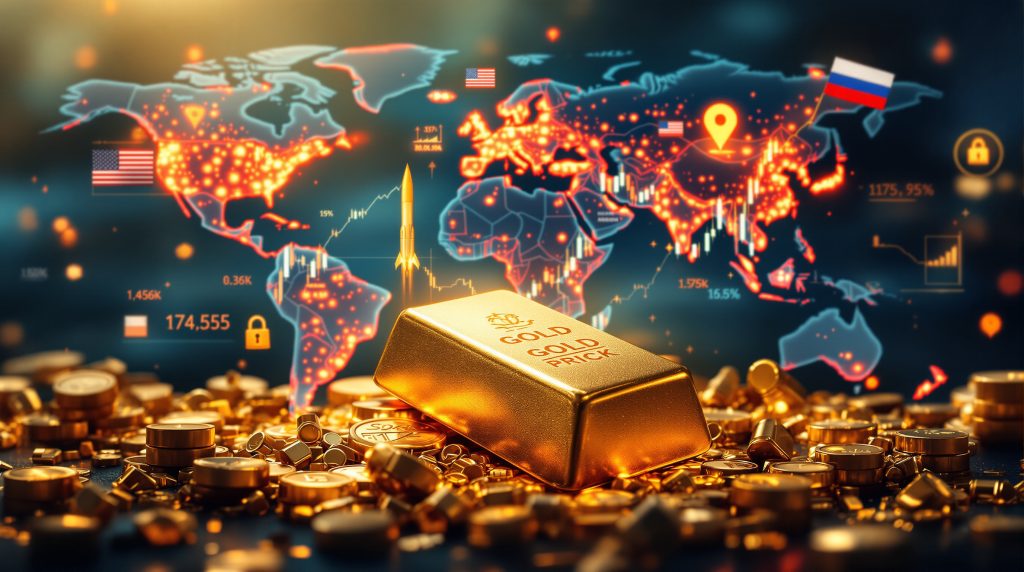How Does Geopolitical Risk Impact the Gold Market?
The intricate relationship between global tensions and gold prices has been a defining feature of financial markets for centuries. As international conflicts intensify, gold emerges as a critical safe-haven asset, demonstrating its enduring role as a store of value during uncertain times. Understanding this relationship provides valuable insight for investors navigating today's complex geopolitical landscape where gold strategic investment decisions become increasingly crucial.
What Makes Gold Respond to Geopolitical Events?
The Safe-Haven Effect
Gold's reputation as the ultimate safe-haven asset stems from its intrinsic properties and historical performance during crises. Unlike currencies or equities, gold isn't tied to any specific government or corporation, making it relatively immune to the direct impacts of political instability.
When geopolitical tensions escalate, investors typically redirect capital from riskier assets toward gold, creating significant price movements. Historical analysis reveals that during periods of heightened geopolitical uncertainty, gold has delivered average weekly returns of approximately 1.6%, while equity markets often experience simultaneous declines.
This pattern was vividly illustrated recently when record gold prices reached $3,770 per ounce amid escalating global tensions, demonstrating its continued relevance as what market veteran Clem Chambers describes as the "currency of war."
Currency Devaluation Protection
Geopolitical conflicts frequently trigger currency devaluations, particularly in directly affected regions. As local currencies weaken, domestic investors in these areas often increase their gold holdings as a protective measure. This behavior creates additional demand pressure, supporting higher gold prices globally.
Between 2022-2025, currencies in conflict-affected regions experienced devaluations ranging from 15-30%, while gold prices strengthened substantially against these same currencies, providing empirical evidence of this protective function.
How Different Types of Geopolitical Risks Affect Gold
Military Conflicts and Gold Price Volatility
Military conflicts represent the most dramatic form of geopolitical risk and typically generate the most pronounced reactions in gold markets. The pattern generally follows three distinct phases:
-
Initial Shock Phase: When conflict begins or escalates unexpectedly, gold prices often spike sharply, sometimes gaining 2-5% within days.
-
Sustained Tension Phase: As conflicts persist, gold typically maintains elevated levels but with reduced volatility, supported by ongoing safe-haven demand.
-
Resolution/De-escalation Phase: When tensions ease, gold prices often retreat gradually, though rarely returning to pre-conflict levels immediately.
Recent conflicts in Eastern Europe and the Middle East have followed this pattern, with gold experiencing initial price jumps of 3-4% followed by sustained elevated trading ranges. In 2022-2023, gold prices surged approximately 8% in the first month of the Eastern European conflict, then stabilized at levels 10-15% above pre-conflict prices.
Trade Wars and Economic Sanctions
Trade disputes and economic sanctions represent a different category of geopolitical risk that impacts gold through economic uncertainty rather than immediate security concerns.
These situations typically produce:
- More gradual gold price appreciation (0.5-1.5% weekly gains)
- Longer-lasting price supports as economic impacts unfold slowly
- Correlation with currency movements, particularly involving major economies
The 2023-2025 trade tensions between major economic powers demonstrated this pattern, with gold appreciating approximately 18% over an 18-month period as tariffs and counter-tariffs disrupted global commerce.
Regional Political Instability
Political instability within significant gold-producing regions creates a unique dynamic where supply concerns amplify price responses. When unrest affects major gold-producing nations like South Africa, Russia, or Peru, the market reacts to both the general geopolitical risk and specific supply disruption fears.
These situations can create price premiums of 2-3% above what might be expected from similar geopolitical events in non-gold-producing regions.
Central Banks' Response to Geopolitical Risk
Strategic Reserve Diversification
Central banks have increasingly used gold as a strategic diversification tool in response to geopolitical uncertainties. This trend represents a fundamental shift in the geopolitical risk in the gold market over the past decade.
Between 2023 and 2025, central banks collectively added over 1,500 tonnes to their reserves, with institutions from countries facing direct geopolitical pressures being particularly aggressive buyers. This central bank demand has created a durable price floor that has raised gold's baseline trading range.
A notable example comes from Poland, whose Minister of Finance publicly showcased the country's gold purchases as part of their strategic reserves. This move reflects growing concerns about supply chain resilience and the need for tangible assets during periods of international tension.
The De-Dollarization Effect
Geopolitical tensions have accelerated efforts by some nations to reduce dependence on the U.S. dollar, with gold serving as an alternative reserve asset. This "de-dollarization" trend has been particularly evident among countries facing Western sanctions or those seeking greater monetary autonomy.
Central banks from these nations have increased their gold allocation from an average of 8% of reserves to nearly 15% between 2020 and 2025, creating sustained buying pressure in the market.
How Geopolitical Risk Interacts with Other Gold Price Drivers
The Interest Rate Connection
While geopolitical events can trigger sharp gold price movements, the sustainability of these moves depends heavily on the prevailing interest rate environment. Gold's opportunity cost (the yield foregone by holding non-interest-bearing gold) plays a crucial role in determining how long geopolitical risk premiums persist.
In high interest rate environments, geopolitical risk may cause temporary spikes that gradually fade as the opportunity cost reasserts itself. Conversely, in low interest rate environments, geopolitical risk can trigger more sustained price appreciation.
The relationship can be summarized as:
| Interest Rate Environment | Typical Gold Response to Geopolitical Risk |
|---|---|
| Rising Rates | Sharp but often temporary price spikes |
| Stable High Rates | Moderate, short-lived appreciation |
| Falling Rates | Strong, potentially sustained rallies |
| Low/Negative Rates | Maximum sensitivity to geopolitical events |
Inflation Expectations
Geopolitical conflicts that threaten energy supplies or disrupt global trade often raise inflation expectations, creating a secondary support mechanism for gold prices. The commodity has historically performed well during inflationary periods, and geopolitical events that trigger inflation concerns can amplify gold's price response.
During the 2023-2025 period, conflicts affecting major energy-producing regions contributed to inflation expectations rising by 1-2 percentage points in many economies, coinciding with a 25% increase in gold prices.
Recent examples include Brent crude oil trading near $70 per barrel following Ukrainian strikes on Russian energy infrastructure, recording its biggest weekly gain in 3 months. These energy supply disruptions create inflationary pressures that typically benefit gold as a protective asset.
Investment Flows During Geopolitical Crises
ETF and Physical Gold Demand Patterns
Geopolitical events trigger distinct patterns in gold investment flows, with important differences between institutional and retail behavior:
-
Institutional Flows: During geopolitical crises, gold ETF holdings typically increase by 2-4% within the first month, reflecting large-scale portfolio adjustments by institutional investors seeking to hedge risk.
-
Retail Physical Demand: Retail investors often respond more dramatically to geopolitical events, particularly in directly affected regions. Premium spikes of 5-10% above spot prices for physical gold are common in areas experiencing acute geopolitical stress.
The 2024-2025 period saw gold ETF holdings increase by approximately 350 tonnes during periods of heightened geopolitical tension, while physical premiums in affected regions reached 8-12% above global spot prices.
Regional Variations in Response
The gold market's response to geopolitical events shows significant regional variation, with proximity to conflicts playing a major role:
- Investors in regions directly affected by conflicts typically increase gold allocations by 3-5 percentage points in their portfolios
- Investors in neighboring regions typically increase allocations by 1-3 percentage points
- Distant markets may show minimal portfolio adjustments unless the conflict has global implications
Predicting Gold's Response to Future Geopolitical Events
Key Indicators to Monitor
Several key indicators help predict how strongly gold will respond to emerging geopolitical risks:
-
VIX Index (Market Volatility): When the VIX is already elevated (>25), gold's response to new geopolitical events tends to be magnified.
-
U.S. Dollar Strength: Geopolitical events occurring during periods of dollar weakness typically generate stronger gold price responses.
-
Existing Gold Positioning: Market events that occur when speculative positioning in gold is already heavily long tend to produce smaller price reactions than those occurring when positioning is neutral or short.
-
Energy Market Disruption: Geopolitical events that threaten energy supplies typically generate 30-40% stronger gold price responses than events with minimal energy implications.
The Duration Effect
The market's perception of a geopolitical event's duration significantly impacts gold's price response. Events viewed as temporary disruptions typically generate short-lived price spikes, while those perceived as fundamental shifts in the geopolitical landscape can create sustained price support.
Analysis of past conflicts suggests that for each month a major geopolitical crisis is expected to continue, gold tends to maintain a 0.5-1% price premium above its pre-crisis baseline.
Case Studies: Gold's Response to Recent Geopolitical Events
Eastern European Conflict (2022-2025)
The prolonged conflict in Eastern Europe provides a textbook example of gold's response to sustained geopolitical tension:
- Initial Phase (February-March 2022): Gold prices surged approximately 8% in the first month of the conflict
- Intermediate Phase (2022-2023): Prices stabilized at elevated levels, trading in a range 10-15% above pre-conflict levels
- Extended Phase (2024-2025): As the conflict became normalized but unresolved, gold maintained a structural risk premium of approximately 5-7%
Most recently, NATO's direct warning to Russia about potential airspace violations has renewed the "geopolitical risk in the gold market" premium, as described by market analysts. This demonstrates how specific diplomatic escalations can trigger immediate price responses in precious metals markets.
Middle East Tensions (2023-2025)
Escalating tensions in the Middle East demonstrated how energy supply concerns amplify gold's response to geopolitical events:
- When conflicts threatened major shipping routes in 2023-2024, gold prices gained 12% over a six-week period
- The correlation between oil price volatility and gold prices strengthened to 0.78 during this period, compared to a long-term average of 0.42
- Central banks in the region increased gold purchases by approximately 35% during this period
How Investors Can Navigate Geopolitical Risk in the Gold Market
Portfolio Allocation Strategies
Investors can implement several investment strategies for gold to optimize exposure during periods of heightened geopolitical risk:
-
Dynamic Allocation: Increasing gold allocation by 2-5 percentage points during periods of elevated geopolitical tension, then reducing as tensions normalize
-
Options Strategies: Using options to create asymmetric exposure to gold price movements during uncertain geopolitical periods
-
Diversified Risk Approach: Combining gold with silver or platinum group metals for a more comprehensive precious metals exposure. As one market expert notes, "You need a diversified portfolio of risk, and you need to know why you own your assets."
-
Silver as a Complementary Investment: With silver trading at approximately $46 per ounce, some analysts believe it has potential to reach $100, providing a complementary investment to gold. The historical 8:1 mining ratio between silver and gold by weight compared to the 80:1 price ratio suggests potential for outperformance during periods of heightened risk.
Technical Analysis Considerations
Technical analysis patterns often behave differently during geopolitical crises. Key differences include:
- Support and resistance levels tend to be less reliable during acute geopolitical events
- Volume indicators become particularly important, with sustained high volume needed to confirm trend changes
- Volatility bands (such as Bollinger Bands) typically expand by 30-50% during major geopolitical events
The Future of Geopolitical Risk in the Gold Market
Evolving Risk Landscape
The nature of geopolitical risk continues to evolve, with several emerging trends likely to impact gold markets in coming years:
-
Resource Nationalism: Growing government intervention in critical mineral sectors, including gold, creating new types of supply risks
-
Technological Warfare: Cyber conflicts and technology restrictions creating new categories of geopolitical risk that may drive safe-haven demand
-
Climate Security: Environmental challenges creating new geopolitical tensions that may influence commodity markets broadly
-
Strategic Metal Reserves: Nations are increasingly building strategic reserves of critical metals beyond gold. As observed in recent market behavior, platinum and palladium have gained significant importance, with platinum prices reaching $1,400 per ounce. Despite sanctions on Russia in many sectors, the U.S. continues to import Russian platinum and palladium due to their strategic importance and limited global production of approximately 200 tons annually.
Digital Gold vs. Physical Gold During Crises
An important emerging trend is the divergent behavior of digital and physical gold during geopolitical crises:
- Physical gold typically commands increasing premiums during acute crises, especially in directly affected regions
- Digital gold products (ETFs, allocated accounts) may experience liquidity advantages during global market disruptions
- The gap between physical and digital gold pricing tends to widen by 2-4% during major geopolitical events
FAQ: Geopolitical Risk and Gold Investments
How quickly does gold typically respond to sudden geopolitical events?
Gold markets typically begin responding to major geopolitical events within hours, with price movements of 1-3% common within the first 24-48 hours following significant developments. However, the full impact often unfolds over days or weeks as investors assess the broader implications and repositioning occurs across portfolios.
Do all types of geopolitical events affect gold equally?
No, gold responds differently to various types of geopolitical events. Military conflicts typically generate the strongest and most immediate price reactions, while diplomatic tensions or political transitions may produce more muted responses. Events threatening energy supplies or global trade routes generally create stronger gold price reactions than localized political developments.
How does gold compare to other safe-haven assets during geopolitical crises?
While gold is the traditional geopolitical safe haven, it's not the only option. Comparative analysis shows:
| Safe Haven Asset | Typical Performance During Geopolitical Crises | Key Advantages | Key Limitations |
|---|---|---|---|
| Gold | +1.5% to +4% monthly | Universal acceptance, high liquidity | No yield, storage costs |
| Swiss Franc | +0.8% to +2% monthly | Stability, banking privacy | Tied to monetary policy |
| U.S. Treasuries | Price appreciation of 1-3% | Exceptional liquidity, yield | Dollar dependency |
| Japanese Yen | +0.5% to +1.5% monthly | Liquidity, carry trade unwinding | Economic vulnerability |
Should investors increase gold allocation in anticipation of geopolitical events?
Attempting to time geopolitical events is extremely difficult. Rather than trying to anticipate specific events, investors might consider maintaining a strategic gold allocation (typically 5-10% of a diversified portfolio) that provides ongoing protection against unforeseen developments. This allocation can be adjusted based on the general geopolitical climate rather than specific event predictions.
Conclusion: Gold's Enduring Role in Geopolitical Risk Management
Gold's response to geopolitical risk remains one of its most defining characteristics as an asset class. While the specific price impacts vary based on the nature of events, broader economic conditions, and existing market positioning, gold consistently demonstrates its value as a portfolio stabilizer during periods of international tension.
The complex interplay between geopolitical events, monetary policy, inflation expectations, and investment flows means that gold's price response is rarely simple or linear. However, the historical pattern of gold serving as a crisis hedge continues to hold true, reinforcing its role in modern portfolio construction.
As the geopolitical landscape continues to evolve, with new forms of international competition and conflict emerging, gold's historical role as the ultimate safe-haven asset appears likely to persist, providing investors with a tangible hedge against the unpredictable nature of global affairs. Looking ahead, the gold price forecast suggests continued strength, particularly as gold-silver ratio insights point to interesting opportunities in the precious metals sector.
Disclaimer: This article contains forward-looking statements and predictions about potential market movements. These statements are speculative in nature and should not be considered as investment advice. All investments carry risk, and past performance is not indicative of future results.
Looking for an Edge in ASX Mining Discoveries?
Gain immediate alerts on significant ASX mineral discoveries through Discovery Alert's proprietary Discovery IQ model, which turns complex geological announcements into actionable investment opportunities. Explore how historic discoveries have generated substantial returns for investors by visiting the dedicated discoveries page and position yourself ahead of the market.




